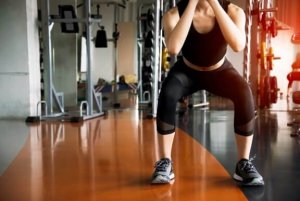6 Mistakes People Make When Trying to Get Strong Legs

In this article, we’ll show you the mistakes you might be unconsciously making, and that keep you from developing strong legs. Take notes and apply the necessary adjustments!
Strong legs are a sign of a good training routine, and in turn, they facilitate the performance of several sports such as swimming, football or even dancing. However, there are some details that you may be doing wrong and that hold back your progress.
What to avoid if you want to have strong legs
Many factors come into play to have strong legs. Factors such as the type and frequency of the workout, the diet, hydration and metabolism of the person, among others. Making mistakes regarding these aspects not only impinges upon the strength development of your legs but it could also cause injuries. Therefore, you must avoid the following mistakes as much as possible:
1. Not working your legs frequently
Some athletes, once they reach a certain level of strength on their legs or when their muscles are already defined, stop training their legs with the same effort. This is a very big mistake if their goal is to have strong legs.
You should train your legs as frequently as the rest of your body. This way, they’ll not be weak in comparison to other extremities. Beyond looks, it’s not healthy to prioritize other areas and undervalue your legs.
2. Doing just one kind of exercise
Focusing on just one kind of exercise because it’s good for your legs doesn’t mean you will get strong legs. You must switch up the movements you make in order to strengthen all the muscles in your legs.

Doing cardio, machines, running or jogging are good options. However, squats and all their variations are essential and effective as well. If you don’t do many squats, it’s time to change that and include them in your leg training routine.
3. Not eating right
Bad eating habits keep you from having strong and healthy legs. It’s important to maintain a healthy diet so that exercise can have its full effect. Working out and expecting good results with a malnourished body is not only impossible but also dangerous for your health.
Likewise, vegetables and proteins are great allies to strengthen your muscle tissues. We recommend ingesting a good amount of protein, preferably natural protein such as meat, fish, and vegetables, among others.
4. Simple workouts
Doing simple workouts that are not challenging and don’t require a lot of effort will cause you to become stuck at a strength level. You must do routines that demand your full potential so that you can develop muscular abilities gradually.
Don’t settle for doing only 50 squats; increase the difficulty every single day. It’s worth mentioning that the increase in difficulty must be gradual and not sudden. This is because, demanding more than what your body can give is dangerous for your muscles, ligaments, and joints.
5. Incorrectly performing the exercises
A bad execution of the exercises you do is a very common but serious mistake. Working out in the wrong way slows down the process of strengthening your muscles because you’re not stimulating them as you should.
Besides, performing the exercises incorrectly could be risky for your body; you could injure yourself or experience muscle cramps. You must make sure you perform the right technique for each exercise and use the appropriate muscles.

6. Not resting for the necessary time
Rest is fundamental for every athlete since it’s in this period when the muscles recover from a day of doing sports. Not resting enough is damaging if you want to get strong legs since you don’t give your muscles the chance to repair the tears completely; therefore, it’s like working out in vain.
There’s not an estimated time of rest for athletes, but there’s an average requirement of eight hours of sleep. However, each body is different. Which is why you should define your resting period on your own. You must rest for as long as your body demands; this is usually defined by the energy you spent throughout the day.
Having strong legs may seem easy, but the truth is that it requires a lot of work, effort, and dedication. Progress won’t happen overnight. The key is to be patient, constant and avoid the mistakes we talked about in this article. Other than that, it’s enough to train hard, eat and rest correctly.
In this article, we’ll show you the mistakes you might be unconsciously making, and that keep you from developing strong legs. Take notes and apply the necessary adjustments!
Strong legs are a sign of a good training routine, and in turn, they facilitate the performance of several sports such as swimming, football or even dancing. However, there are some details that you may be doing wrong and that hold back your progress.
What to avoid if you want to have strong legs
Many factors come into play to have strong legs. Factors such as the type and frequency of the workout, the diet, hydration and metabolism of the person, among others. Making mistakes regarding these aspects not only impinges upon the strength development of your legs but it could also cause injuries. Therefore, you must avoid the following mistakes as much as possible:
1. Not working your legs frequently
Some athletes, once they reach a certain level of strength on their legs or when their muscles are already defined, stop training their legs with the same effort. This is a very big mistake if their goal is to have strong legs.
You should train your legs as frequently as the rest of your body. This way, they’ll not be weak in comparison to other extremities. Beyond looks, it’s not healthy to prioritize other areas and undervalue your legs.
2. Doing just one kind of exercise
Focusing on just one kind of exercise because it’s good for your legs doesn’t mean you will get strong legs. You must switch up the movements you make in order to strengthen all the muscles in your legs.

Doing cardio, machines, running or jogging are good options. However, squats and all their variations are essential and effective as well. If you don’t do many squats, it’s time to change that and include them in your leg training routine.
3. Not eating right
Bad eating habits keep you from having strong and healthy legs. It’s important to maintain a healthy diet so that exercise can have its full effect. Working out and expecting good results with a malnourished body is not only impossible but also dangerous for your health.
Likewise, vegetables and proteins are great allies to strengthen your muscle tissues. We recommend ingesting a good amount of protein, preferably natural protein such as meat, fish, and vegetables, among others.
4. Simple workouts
Doing simple workouts that are not challenging and don’t require a lot of effort will cause you to become stuck at a strength level. You must do routines that demand your full potential so that you can develop muscular abilities gradually.
Don’t settle for doing only 50 squats; increase the difficulty every single day. It’s worth mentioning that the increase in difficulty must be gradual and not sudden. This is because, demanding more than what your body can give is dangerous for your muscles, ligaments, and joints.
5. Incorrectly performing the exercises
A bad execution of the exercises you do is a very common but serious mistake. Working out in the wrong way slows down the process of strengthening your muscles because you’re not stimulating them as you should.
Besides, performing the exercises incorrectly could be risky for your body; you could injure yourself or experience muscle cramps. You must make sure you perform the right technique for each exercise and use the appropriate muscles.

6. Not resting for the necessary time
Rest is fundamental for every athlete since it’s in this period when the muscles recover from a day of doing sports. Not resting enough is damaging if you want to get strong legs since you don’t give your muscles the chance to repair the tears completely; therefore, it’s like working out in vain.
There’s not an estimated time of rest for athletes, but there’s an average requirement of eight hours of sleep. However, each body is different. Which is why you should define your resting period on your own. You must rest for as long as your body demands; this is usually defined by the energy you spent throughout the day.
Having strong legs may seem easy, but the truth is that it requires a lot of work, effort, and dedication. Progress won’t happen overnight. The key is to be patient, constant and avoid the mistakes we talked about in this article. Other than that, it’s enough to train hard, eat and rest correctly.
All cited sources were thoroughly reviewed by our team to ensure their quality, reliability, currency, and validity. The bibliography of this article was considered reliable and of academic or scientific accuracy.
- Delavier, F. (2010). Strength Training Anatomy. Human Kinetics (Fifth Ed., Vol. 0). https://doi.org/10.1519/0199-610X(1982)004<0022:CIGASP>2.3.CO;2
-
Close, G. L., Hamilton, D. L., Philp, A., Burke, L. M., & Morton, J. P. (2016). New strategies in sport nutrition to increase exercise performance. Free Radical Biology and Medicine, 98, 144–158. https://doi.org/10.1016/j.freeradbiomed.2016.01.016
This text is provided for informational purposes only and does not replace consultation with a professional. If in doubt, consult your specialist.








